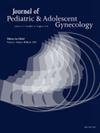53. Implementation of an Enhanced Recovery After Surgery Pathway in Adolescent Patients Undergoing Laparoscopic Evaluation of Endometriosis
IF 1.8
4区 医学
Q3 OBSTETRICS & GYNECOLOGY
引用次数: 0
Abstract
Background
In July 2023, a multi-disciplinary team from a tertiary children's hospital implemented an enhanced recovery after surgery (ERAS) pathway to standardize care and improve the perioperative experience for adolescents undergoing diagnostic laparoscopy for endometriosis. Pathway components include pre-operative gynecologic and anesthesia visits, intraoperative multimodal analgesia, and postoperative management (Fig 1 & 2). This study aimed to (1) assess perioperative compliance to the Endometriosis ERAS pathway, and (2) evaluate patient metrics as indicators for pathway efficacy pre- and post- pathway implementation.
Methods
This was an IRB approved, single-site study of patients aged 12-20 undergoing laparoscopy for endometriosis. Data was collected from 6/2022-6/2023 (pre-ERAS) and 8/2023- 8/2024 (post-ERAS). To assess pathway compliance (aim 1) the rates of preoperative prescription, referral placement, day of surgery preoperative medication, preoperative carbohydrate loading, intraoperative anesthesia bundle, and postoperative prescriptions were measured. Post Anesthesia Care Unit (PACU) length of stay, discharge pain score, and patient concerns (ER visit, phone call/message, or readmissions) were interpreted as surrogate metrics for pathway efficacy (aim 2) and were analyzed pre and post intervention using independent t-tests and Chi squared/Fisher's exact tests. All data analysis was performed using SPSS.
Results
53 patients were included (20 pre and 33 post-ERAS). Mean age was 16.6 years (SD 1.7). Compliance was as follows: 81% preoperative prescriptions, 45% pain management referrals, 33% physical/occupational therapy, 76% day of surgery preoperative medications, 39% preoperative carbohydrate load, 87% intraoperative bundle compliance, and 61% postoperative prescriptions. PACU length of stay, discharge pain scores, and patient concerns were not significantly different pre vs post ERAS.
Conclusions
The Endometriosis ERAS pathway was a multidisciplinary team effort and has overall high compliance but leaves room for improvement in some facets (particularly specialty referrals and preoperative carbohydrate loading). While our data does not show improved patient metrics in the pre vs post pathway group, this is likely reflective of our efforts to emulate this pathway in the year leading up to implementation. Future directions include: analyzing a pre-ERAS group more remote from the pathway start date, revisiting the multidisciplinary team to see what barriers exist to improve compliance, and eliciting qualitative feedback from patients about their perspective.
53. 腹腔镜评估子宫内膜异位症青少年患者术后恢复途径的实施
2023年7月,一家三级儿童医院的多学科团队实施了一项增强术后恢复(ERAS)途径,以标准化护理并改善接受腹腔镜诊断子宫内膜异位症的青少年的围手术期体验。路径组成部分包括术前妇科和麻醉访问、术中多模式镇痛和术后管理(图1和amp;2).本研究旨在(1)评估子宫内膜异位症ERAS通路的围手术期依从性,(2)评估患者指标作为通路实施前后疗效的指标。方法:这是一项经IRB批准的单点研究,研究对象是12-20岁的子宫内膜异位症患者。数据收集于6/2022-6/2023 (era前)和8/2023- 8/2024 (era后)。为了评估通路依从性(目的1),我们测量了术前处方、转诊安排、手术天数、术前用药、术前碳水化合物负荷、术中麻醉束和术后处方的比例。麻醉后护理单位(PACU)的住院时间、出院疼痛评分和患者关注的问题(急诊室就诊、电话/信息或再入院)被解释为途径疗效的替代指标(目的2),并使用独立t检验和卡方/费雪精确检验分析干预前后。所有数据均采用SPSS进行分析。结果共纳入53例患者(eras前20例,eras后33例)。平均年龄16.6岁(SD 1.7)。依从性如下:81%的术前处方,45%的疼痛管理转诊,33%的物理/职业治疗,76%的术前用药,39%的术前碳水化合物负荷,87%的术中束依从性,61%的术后处方。PACU住院时间、出院疼痛评分和患者关注点在ERAS前后无显著差异。结论子宫内膜异位症ERAS途径是一个多学科团队的努力,总体上具有很高的依从性,但在某些方面(特别是专科转诊和术前碳水化合物负荷)仍有改进的余地。虽然我们的数据并没有显示出治疗前和治疗后患者指标的改善,但这可能反映了我们在实施前一年模仿该治疗方法的努力。未来的发展方向包括:分析离途径开始日期更远的前eras组,重新访问多学科团队,看看存在什么障碍来提高依从性,并从患者那里获得关于他们观点的定性反馈。
本文章由计算机程序翻译,如有差异,请以英文原文为准。
求助全文
约1分钟内获得全文
求助全文
来源期刊
CiteScore
3.90
自引率
11.10%
发文量
251
审稿时长
57 days
期刊介绍:
Journal of Pediatric and Adolescent Gynecology includes all aspects of clinical and basic science research in pediatric and adolescent gynecology. The Journal draws on expertise from a variety of disciplines including pediatrics, obstetrics and gynecology, reproduction and gynecology, reproductive and pediatric endocrinology, genetics, and molecular biology.
The Journal of Pediatric and Adolescent Gynecology features original studies, review articles, book and literature reviews, letters to the editor, and communications in brief. It is an essential resource for the libraries of OB/GYN specialists, as well as pediatricians and primary care physicians.

 求助内容:
求助内容: 应助结果提醒方式:
应助结果提醒方式:


